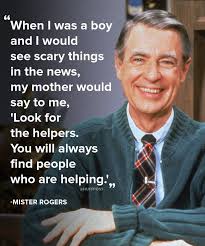Mental Health Mondays
Explaining News to Children
When I was a boy and I would see scary things in the news, my mother would say to me, “Look for the helpers. You will always find people who are helping.”
While it is best to protect children from news stories that they are too young to fully understand and cope with, there are times when pieces of stories are overheard or when children pick up on their parents’ distress. Since young children derive their sense of safety primarily from their parents, the simple words of Mr. Rogers’ mother are so wise in how they convey the confidence that, no matter what has happened, there are always more of the good, helping people in the world than anything else.
Elementary-aged children will inevitably hear and know at least parts of what took place at the Capitol last week. While they may not bring up the topic on their own, they may be left with questions, confusion, or uncomfortable feelings. Depending on the child’s age, we encourage you to be proactive in sharing what feels like an age-appropriate description of the events and leaving the door open for any questions they may have, all while conveying that your family is safe.
There are many ways that children show that they feel unsafe. Our teachers and clinicians have a keen understanding of the subtleties of behavior, often picking up on the signs that something has shifted and knowing that behind the behavior is a child feeling frightened, insecure, or threatened in some way. In this period of traumatic and tumultuous events in the news, we encourage you to look out for behaviors that are out of the ordinary and that may indicate that your child is feeling worried or unsettled by current events. Be present, listen, and give a little extra support if you notice that there have been changes in behavior. Simply reminding children of the hope and promise of help and support as Mr. Rogers’ mother did goes a long way in strengthening our collective sense of safety and wellbeing.



